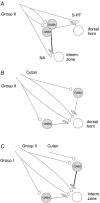Differential presynaptic inhibition of actions of group II afferents in di- and polysynaptic pathways to feline motoneurones
- PMID: 12096070
- PMCID: PMC2315796
- DOI: 10.1113/jphysiol.2001.014068
Differential presynaptic inhibition of actions of group II afferents in di- and polysynaptic pathways to feline motoneurones
Abstract
The aim of this study was to investigate differences in the effects of presynaptic inhibition of transmission from group II muscle afferents to neurones in the dorsal horn and in the intermediate zone and the consequences of these differences for reflex actions of group II afferents upon alpha-motoneurones. The degree of presynaptic inhibition was estimated from the degree of depression of monosynaptic components of population EPSPs (field potentials) evoked by group II muscle afferents in deeply anaesthetized cats. The decrease in the area of field potentials was considerably larger and longer lasting in the intermediate zone, where they were often obliterated, than in the dorsal horn, where they were reduced to about two-thirds. Presynaptic inhibition of field potentials evoked by other afferents at the same locations was much weaker. Intracellular records from alpha-motoneurones revealed that short latency EPSPs and IPSPs evoked from group II afferents are considerably reduced by conditioning stimuli that effectively depress intermediate zone field potentials of group II origin. The results of this study lead to the conclusion that strong presynaptic inhibition of transmission to intermediate zone interneurones allows a selective depression of disynaptic actions of group II muscle afferents on alpha- and gamma-motoneurones, mediated by these interneurones, and favours polysynaptic actions of these afferents.
Figures








Similar articles
-
Both dorsal horn and lamina VIII interneurones contribute to crossed reflexes from feline group II muscle afferents.J Physiol. 2003 Nov 1;552(Pt 3):961-74. doi: 10.1113/jphysiol.2003.048009. Epub 2003 Sep 8. J Physiol. 2003. PMID: 12963796 Free PMC article.
-
Presynaptic control of transmission along the pathway mediating disynaptic reciprocal inhibition in the cat.J Physiol. 2000 Aug 1;526 Pt 3(Pt 3):623-37. doi: 10.1111/j.1469-7793.2000.t01-1-00623.x. J Physiol. 2000. PMID: 10922013 Free PMC article.
-
Reflex pathways from group II muscle afferents. 2. Functional characteristics of reflex pathways to alpha-motoneurones.Exp Brain Res. 1987;65(2):282-93. doi: 10.1007/BF00236300. Exp Brain Res. 1987. PMID: 3030794
-
The monosynaptic reflex: a tool to investigate motor control in humans. Interest and limits.Neurophysiol Clin. 2000 Apr;30(2):67-80. doi: 10.1016/s0987-7053(00)00062-9. Neurophysiol Clin. 2000. PMID: 10812576 Review.
-
In search of lost presynaptic inhibition.Exp Brain Res. 2009 Jun;196(1):139-51. doi: 10.1007/s00221-009-1758-9. Epub 2009 Mar 26. Exp Brain Res. 2009. PMID: 19322562 Review.
Cited by
-
Effects of leg muscle tendon vibration on group Ia and group II reflex responses to stance perturbation in humans.J Physiol. 2003 Jul 15;550(Pt 2):617-30. doi: 10.1113/jphysiol.2003.043331. Epub 2003 May 30. J Physiol. 2003. PMID: 12777449 Free PMC article. Clinical Trial.
-
Properties of axon terminals contacting intermediate zone excitatory and inhibitory premotor interneurons with monosynaptic input from group I and II muscle afferents.J Physiol. 2010 Nov 1;588(Pt 21):4217-33. doi: 10.1113/jphysiol.2010.192211. Epub 2010 Sep 13. J Physiol. 2010. PMID: 20837640 Free PMC article.
-
Task-dependent modulation of primary afferent depolarization in cervical spinal cord of monkeys performing an instructed delay task.J Neurophysiol. 2009 Jul;102(1):85-99. doi: 10.1152/jn.91113.2008. Epub 2009 Apr 22. J Neurophysiol. 2009. PMID: 19386753 Free PMC article.
-
Functional subdivision of feline spinal interneurons in reflex pathways from group Ib and II muscle afferents; an update.Eur J Neurosci. 2010 Sep;32(6):881-93. doi: 10.1111/j.1460-9568.2010.07354.x. Epub 2010 Aug 16. Eur J Neurosci. 2010. PMID: 20722720 Free PMC article. Review.
-
Both dorsal horn and lamina VIII interneurones contribute to crossed reflexes from feline group II muscle afferents.J Physiol. 2003 Nov 1;552(Pt 3):961-74. doi: 10.1113/jphysiol.2003.048009. Epub 2003 Sep 8. J Physiol. 2003. PMID: 12963796 Free PMC article.
References
-
- Bras H, Jankowska E, Noga B, Skoog B. Comparison of effects of various types of NA and 5-HT agonists on transmission from group II muscle afferents in the cat. European Journal of Neuroscience. 1990;2:1029–1039. - PubMed
-
- Curtis DR, Lacey G. Prolonged GABA(B) receptor-mediated synaptic inhibition in the cat spinal cord: an in vivo study. Experimental Brain Research. 1998;121:319–333. - PubMed
-
- Eccles R, Lundberg A. Synaptic actions in motoneurones by afferents which may evoke the flexion reflex. Archives Italiennes de Biologie. 1959;97:199–221.
Publication types
MeSH terms
LinkOut - more resources
Full Text Sources
Miscellaneous

